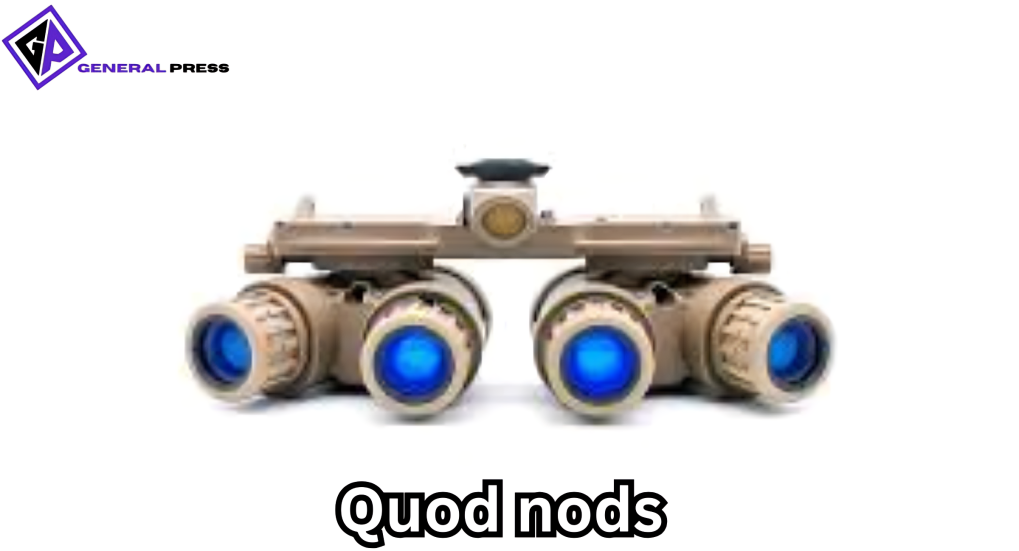In the realm of tactical gear and night vision technology, quad nods have emerged as a game-changing innovation. These sophisticated devices provide unparalleled advantages for professionals operating in low-light or no-light environments. From military personnel to law enforcement officers, and even enthusiasts in the civilian market, quad nods are rapidly becoming the gold standard for night vision. This article explores everything you need to know about quad nods, their functionality, benefits, and how they compare to traditional night vision devices.
What Are Quad Nods?
Quad nods, or quad-tube night vision goggles, are advanced night vision systems that utilize four image intensifier tubes instead of the traditional two. This setup delivers a wider field of view (FOV), typically extending to 97 degrees compared to the 40-degree FOV of standard binocular night vision devices. Quad nods provide users with a significantly enhanced situational awareness, allowing them to detect and respond to threats or obstacles with greater efficiency.
How Do Quad Nods Work?
Also Read: How to Crochet a Floor Rug: 105 Best Patterns for Beginners
Quad nods rely on state-of-the-art image intensification technology. They amplify minimal ambient light, such as starlight or moonlight, to create a clear visual representation of the surroundings. Each of the four tubes is strategically positioned to maximize the field of view:
- Primary Tubes: These central tubes provide forward-facing visibility.
- Peripheral Tubes: These extend the FOV, offering a more comprehensive peripheral vision.
This configuration is particularly advantageous in dynamic environments where rapid visual assessments are critical.
Key Features of Quad Nods
1. Expanded Field of View
The most notable feature of quad nods is their 97-degree field of view, which significantly surpasses the limited FOV of traditional night vision devices. This enhanced visibility minimizes blind spots and provides a more natural viewing experience.
2. Superior Depth Perception
With four tubes working in unison, quad nods offer exceptional depth perception. This is crucial for tasks such as navigating uneven terrain, piloting vehicles, or engaging in close-quarters combat.
3. Enhanced Situational Awareness
The combination of a wider FOV and improved depth perception allows users to maintain heightened situational awareness, making quad nods indispensable for high-stakes missions.
4. Rugged and Durable Design
Quad nodse are built to withstand harsh conditions. They are typically water-resistant, shockproof, and designed to function reliably in extreme temperatures.
5. Compatibility with Accessories
Many quad nod systems are compatible with various accessories, including helmet mounts, thermal overlays, and laser aiming devices, further enhancing their versatility.
Advantages of Quad Nods Over Traditional Night Vision
Broader Vision
The expanded field of view provided by quad nodse is a game-changer for users requiring constant vigilance. Unlike traditional devices that force users to scan their surroundings frequently, quad nodse reduce the need for head movement, ensuring seamless observation.
Operational Superiority
For military and law enforcement personnel, quad nodse offer a tactical edge by providing comprehensive visual coverage in dynamic environments. This translates to faster reaction times and improved mission outcomes.
Comfort and Usability
Despite their advanced capabilities, modern quad nodse are designed to be lightweight and ergonomically friendly, reducing strain during prolonged use.
Applications of Quad Nods
Military Operations
Quad nods are invaluable in combat scenarios, enabling soldiers to navigate and engage in low-light environments with precision.
Law Enforcement
For law enforcement officers, quad nodse enhance surveillance and tactical operations, particularly during nighttime raids or search-and-rescue missions.
Hunting and Outdoor Activities
Civilian enthusiasts, such as hunters and outdoor adventurers, also benefit from the advanced capabilities of quad nods. These devices allow for safer and more effective navigation in the wilderness after dark.
Aviation and Maritime Use
Quad nodse are increasingly being adopted in aviation and maritime sectors, where enhanced night vision is essential for piloting and navigation.
Factors to Consider When Choosing Quad Nods
1. Image Quality
The clarity and resolution of the image intensifiers are paramount. Opt for quad nodse with high-definition image output for optimal performance.
2. Durability
Choose a model with robust construction to ensure it withstands demanding operational conditions.
3. Weight and Comfort
Lightweight designs are essential for extended use without causing discomfort or fatigue.
4. Budget
While quad nodse are an investment, their unparalleled capabilities justify the cost. Prices vary based on features, so consider your specific needs when making a purchase.
Popular Quad Nods Models
1. GPNVG-18
One of the most renowned quad nod systems, the GPNVG-18, is favored for its exceptional field of view and reliable performance in combat scenarios.
2. AN/PVS-31D
While primarily a binocular device, it offers modular upgrades to a quad nod configuration, providing flexibility for various applications.
3. Customized Civilian Models
Several manufacturers produce quad nodse tailored for civilian use, offering a balance between performance and affordability.
Maintenance and Care Tips
To ensure the longevity and performance of your quad nodse:
- Regular Cleaning: Use a soft, lint-free cloth to clean lenses and remove dust or debris.
- Proper Storage: Store the device in a protective case when not in use.
- Avoid Overexposure: Prolonged exposure to bright light can damage image intensifier tubes.
- Periodic Inspections: Check for any signs of wear and tear, and address issues promptly.
FAQ:
1. What are Quad Nods?
Quad Nods (Quad Night Optic Devices) are advanced night vision goggles or systems designed to provide enhanced visibility in low-light or no-light conditions. They typically consist of four high-performance image intensifier tubes, offering superior depth perception, a wider field of view, and increased image clarity compared to traditional night vision systems.
2. How do Quad Nods work?
Quad Nods work by amplifying available light, such as moonlight or infrared light, to produce a visible image. They utilize four image intensifier tubes, each processing the incoming light and converting it into an amplified, visible image. This multi-tube setup enhances performance, providing better clarity, contrast, and depth perception in dark environments.
3. What makes Quad Nods different from standard night vision goggles?
Unlike standard night vision goggles, which usually feature a single or dual tube design, Quad Nodse incorporate four separate tubes. This results in:
- Wider field of view: Quad Nodse provide a broader visual range compared to dual-tube or monocular night vision systems.
- Better depth perception: The extra tubes help in delivering a more three-dimensional image, improving spatial awareness.
- Enhanced clarity: With four tubes working in tandem, Quad Nodse provide clearer and more detailed visuals, especially in challenging lighting conditions.
4. What are the advantages of using Quad Nods?
The main advantages of Quad Nodse include:
- Superior depth perception: Offering a more natural view, as the human brain is better at processing visual information from multiple sources.
- Larger field of view: Providing a wider area of coverage, reducing the need for constant head movement.
- Improved low-light performance: Better image quality in extremely low light situations compared to dual-tube or monocular devices.
- Enhanced situational awareness: Ideal for tactical, military, or search-and-rescue operations where spatial awareness and a broader view are crucial.
5. Are Quad Nods heavier than regular night vision devices?
Yes, Quad Nods are typically heavier than regular single or dual-tube night vision systems due to the additional image intensifier tubes and components. However, advancements in materials and design have helped reduce their weight, making them more comfortable for extended use.
Conclusion
Quad nods represent the pinnacle of night vision technology, offering unmatched capabilities for professionals and enthusiasts alike. Their combination of a wider field of view, superior depth perception, and rugged design makes them an invaluable asset in various applications. As advancements in night vision continue, quad nods are set to remain at the forefront of innovation, providing users with the tactical advantage they need.




